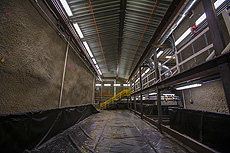NOvA near-detector cavern construction completed, ready for research equipment
 |
The NOvA near-detector cavern is nearly complete. Photo: Cindy Arnold
|
After breaking ground in May 2012, the NOvA near-detector cavern, situated 350 feet underground, is nearly complete—ahead of schedule, no less—and has been ready to accommodate NOvA research equipment since it received beneficial occupancy on May 10.
The lab originally planned for completion in mid-June this year, said FESS engineer Russ Alber. But construction subcontractor Kiewit Infrastructure Co. has been working ahead of schedule and is now ready to turn the cavern over to Fermilab scientists and engineers.
Kiewit is finishing the last steps to cavern construction, which include building a movable walkway that slides down the length of the cavern and entry doors to the cavern.
The empty space is now ready to start taking experiment equipment.
"It's exciting for us," Alber said. "This is not a typical building with typical construction techniques, so we're glad to have completed this one ahead of schedule."
Without all the clutter from building materials, the 75-foot-long cavern seems, well, cavernous.
But it won't be empty for long. Scientists will soon install networking and computing components to process neutrino data once the detector is up and running, said near-detector project manager Ting Miao.
Next month, the team will also begin assembling and installing the near detector's muon catcher and eight PVC detector blocks, using a crane to lower them down the MINOS tunnel and a special transportation cart to position them inside the cavern.
Once installed, the blocks, readout and control electronics and around 700 sensors needed to start taking neutrino data will leave little wiggle room in the cavern, Miao said.
"It will be quite a challenge transferring the detector through the tunnel access shaft and installing it in the detector hall," Miao said. "It's definitely exciting, and many unknowns still lie ahead of us."
Additionally, the lab is working to restore the nearby aboveground areas to their original state, Alber said.
"Although we're running on a tight schedule, I'm amazed every day by how quickly things are moving along," Miao said.
—Sarah Khan
|